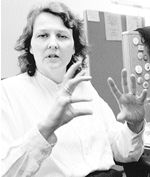|
Adoption: Parent v. Child February 1997
The conflict between the rights of the parent versus the welfare of their children is the age-old social worker’s dilemma. In the June 1996 Ask the Worker family reunification workers spoke out. Many felt that laws protecting the rights of parents were hampering workers from protecting children. Changes to the Welfare and Institutions Code attempt to swing the balance more in favor of the child. New laws will make it much easier to terminate parental rights and to find a permanent home for the child. These changes were in part a response to the large number of children coming into the system from parents addicted to drugs, who have failed in the past to reunify with their children and have very little chance of completing a reunification plan. The laws allow for “fast track adoptions,” shortening the reunification time for children under three years of age to six months, and allows for concurrent planning, placing a child in an adoptive home at the same time a reunification plan is being attempted. Previously, workers were required to provide 12 to 18 months of reunification services, with the child being held in limbo for all that time or even longer before the worker could find a permanent home for the child. But like everything else in the child welfare system, the new laws have both advantages and disadvantages. Ask the Worker spoke with workers to get their opinions.
The Human Dilemma: Children v. Parents Donald Canavan, child welfare worker, Alameda County adoptions, describes the dilemma: “Sometimes I see parents who are making a meager effort, even if they are inept. I feel badly for them; I have mixed feelings. Should we terminate their parental rights? They are clearly not fulfilling the law, but they are trying. But then I look at it from the child’s point of view. I can see that if the child stays with the parents, the child will, in all probability, end up in juvenile hall. If we put the child in an adoptive placement, the kid will have psychological problems from being adopted. But I would rather see a kid go to therapy in 20 years and get the chance to live with a solid family, where the parents have a good job and value a good education, as opposed to a family addicted to drugs and in and out of jail. So from the child’s standpoint I always feel good about adoption, but from the parent’s standpoint I have qualms.” Barbara Woodard, Monterey County, has worked for the Department of Children and Family Services since 1980. She works in permanent placement during the day and emergency response at nights. She is very supportive of concurrent planning in cases where reunification is unlikely to succeed because it makes it less likely that the child will have to move if reunification fails. “I think it is wonderful, because when children move at a young age it has life-long effects. The literature shows that moving children can even damage their intellectual ability.” “Most parents want their children to be loved
and want what is best for them,” Woodard continues. “Not everyone
can raise a kid, and that is why adoptions have been done for centuries.
Relatives and grand parents have always raised kids. We try to identify
the barriers preventing a parent from raising a child in a healthy manner
and then try to determine if we can reasonably provide the services to
correct the problems in a timely manner, so that the child does not spend
years in limbo. We have to look at what is in the best interest of the
child. Children are entitled to a permanent home and to know where they
are going to be next month and next year. In the old days, kids in foster
care would go from home to home until they were teenagers.” Fawnda Sandoval, Los Angeles County placement and recruitment coordinator, organizes the Model Approach to Partnership and Parenting (MAPP) program, providing parenting groups for prospective adoptive parents. She is concerned that the concurrent planning provisions could lead to maternity battles and disappointments. “I worry about recruiting families who want to adopt and then telling them they have to take the risk that they won’t get to keep the child after they have become attached. Someone’s feelings are going to get stepped on, and the child could end up in the middle.” She fears that this may make it even harder to recruit families to adopt, and it will make the job of preparing families even more complex. Many potential adoptive parents don’t even want to consider a child unless parental rights have already been terminated. Who’s to Blame: Many workers worry that the changes in the law are scapegoating dysfunctional parents for society’s problems. Many of these parents are failing because of a lack of decent jobs, schools, housing, and a general deterioration of the social fabric. Social services have been cut so far back, especially in the case of drug rehabilitation, that workers have little more to offer than their own good will in a system that seems, at times, to be more concerned with documentation than actually providing services. Other workers, like Rhea Ann Pritchett, Los Angeles County, feel that even if society has failed parents, the cold hard reality is that many of the parents are not going to be able to recover from their addiction in time to take care of their kids. “There are so many societal factors impacting our clients, and there is such a low success rate. So many times a parent will relapse. How long will it be before a child can return to the home, two years, or five years or ten years? The child is waiting for the parent to rehabilitate and the parent may never rehabilitate.” Triage
Rosemary Reilly, child welfare worker, Alameda County, does the legal paperwork for termination of parental rights. She reports, “Of the cases I have processed in the last three years, 90% of the parents have other children who have been adopted or are in the foster care system. We attempted to do a study to identify which children should be fast-tracked. My feeling is that if parents have two other children they haven’t reunified with, we are wasting a lot of reunification money that could be put into families that are not as systematically dysfunctional. The money would be better used to help other children out of foster care rather than to waste the money indiscriminately. As it is, some of the real victims of the system are working poor people. We need more money for working women, child care, health care, and vocational training.” Los Angeles children’s protective services worker Tim Farrell has qualms about the fast track changes. He fears that placing a child in a potential adoptive home may compromise the reunification plan. He also fears that fast tracking may violate the personal ethics of many children’s protective service workers. He explains, “I feel I can take children from the parent in good conscience, because there is a contract that we are going to do everything we can to help that parent reunify with the children. That is the only way I can sleep at night.” Alameda County family reunification worker Patricia
Hinojosa, like many child welfare workers, has trouble sleeping. She is
haunted not only by the abuse the children in her caseload have suffered,
but also by the realization that she never has enough time to give her
clients the attention they deserve. She worries that shortening reunification
time to six months will make matters worse. “I only have time to
meet with a parent a few times by the six-month hearing. By the time the
case gets to me, it is often at month two or three. With the present caseload,
there’s just not enough time to work with the client.” The new laws provide the tools to expedite the
placement of children into permanent homes and to free up resources by
triaging hopeless cases. But unless something is done about the caseload
overload, paperwork quagmire, and legal morass, the reforms may hardly
be noticed.
|
|||||||||||||||||||






